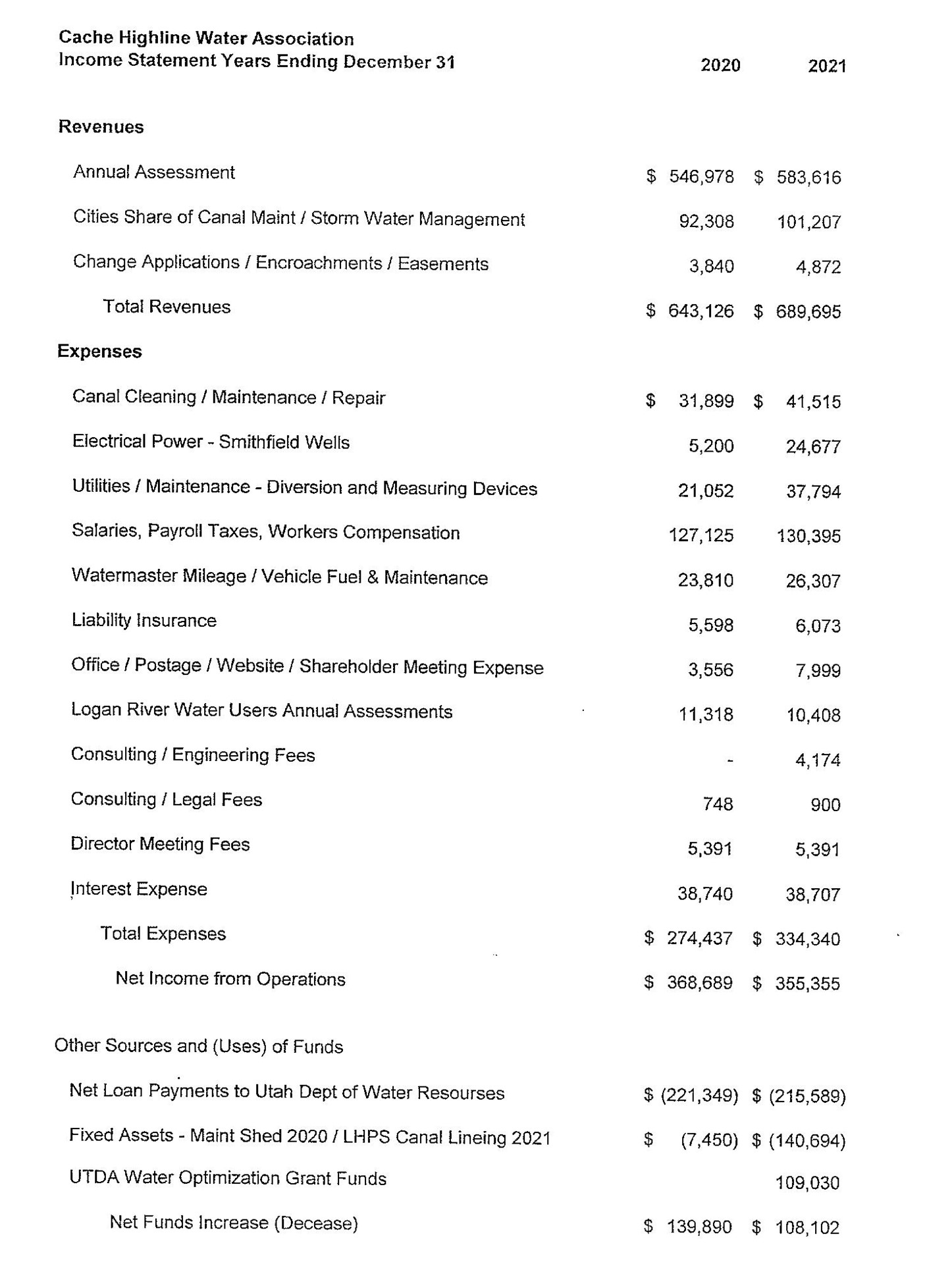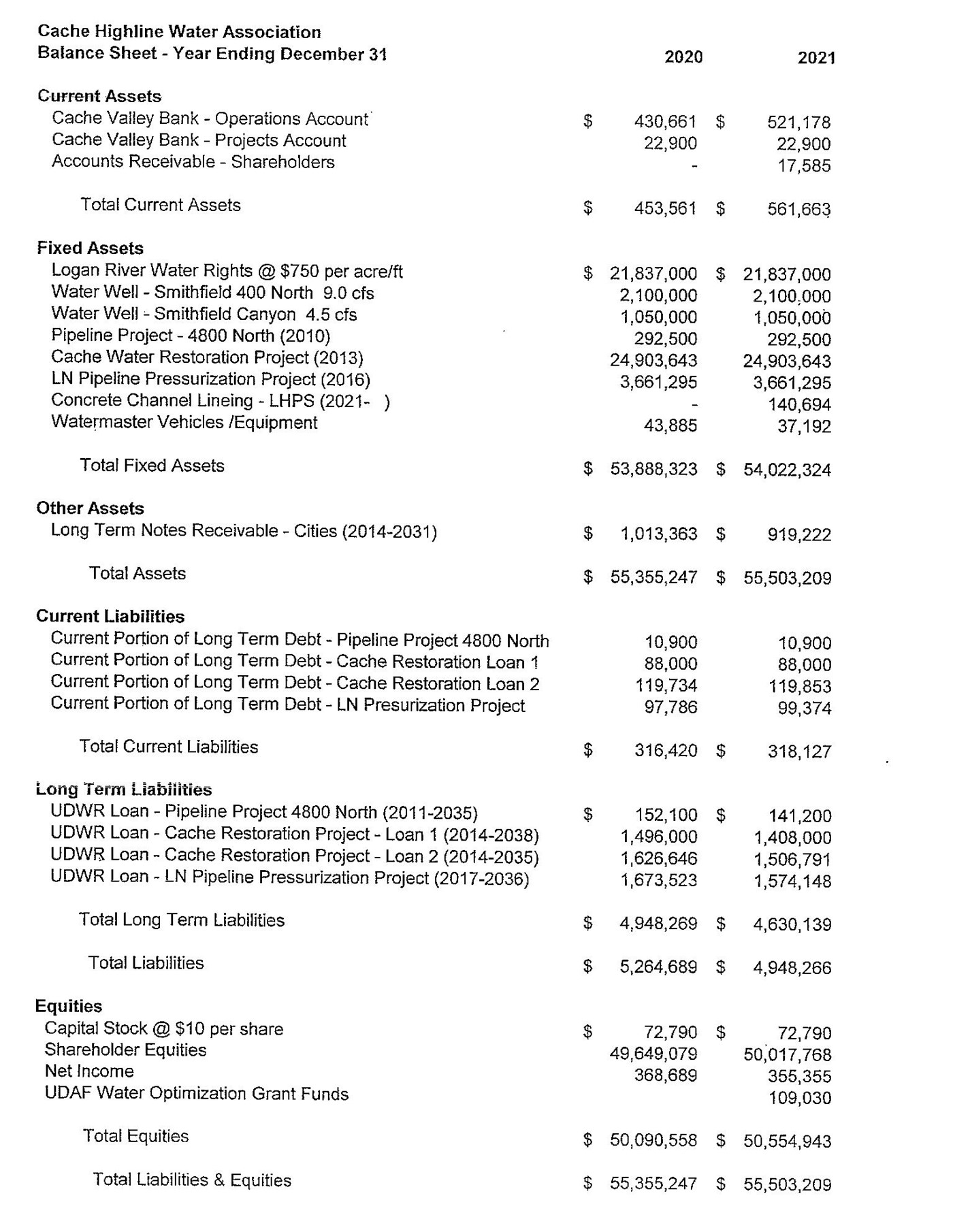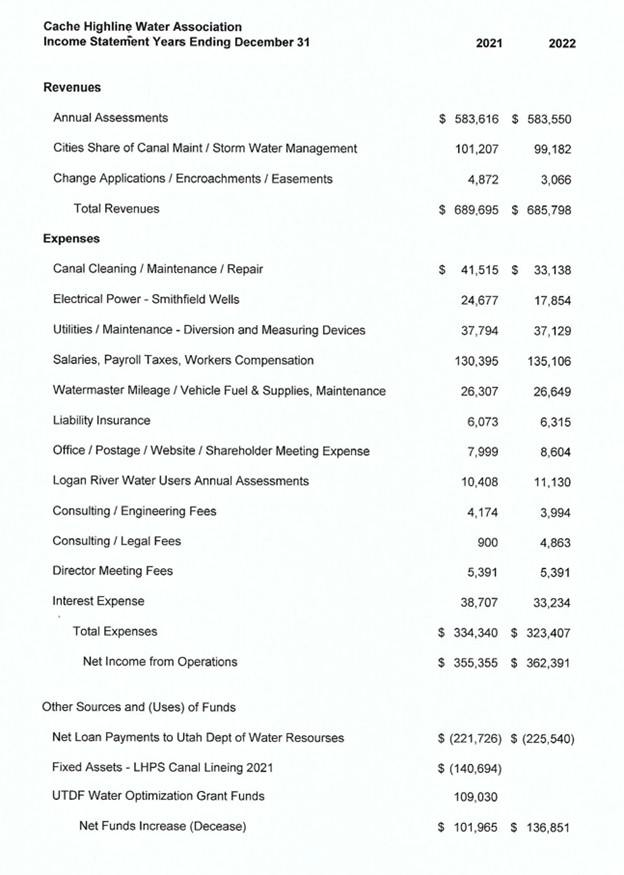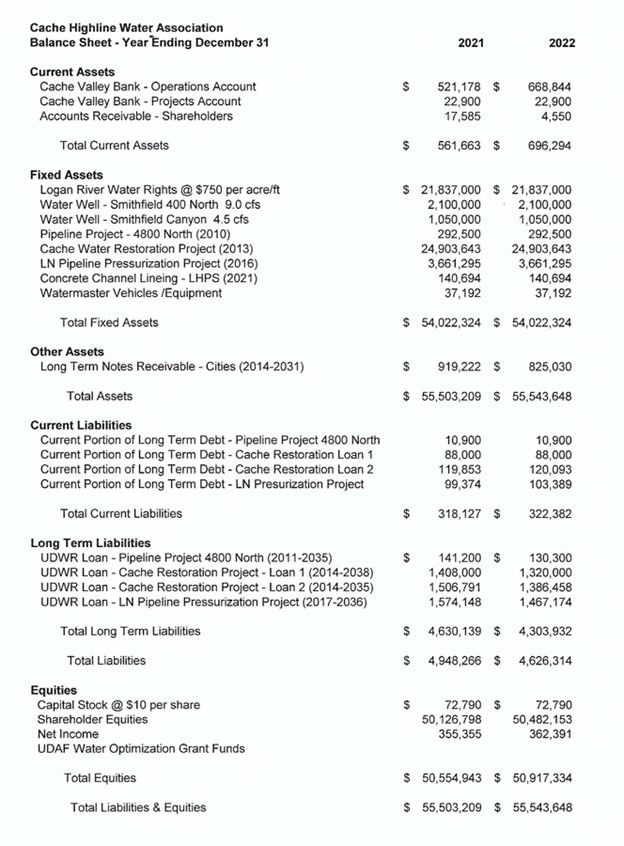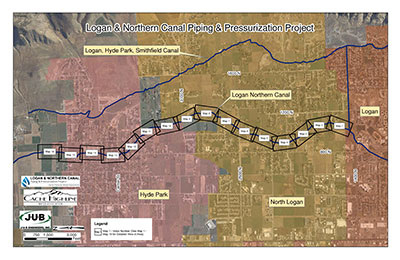The Annual Shareholders’ Meeting
Cache Highline Water Association
April 1, 2019
The Annual Shareholders’ Meeting of the Cache Highline Water Association was held on April 1, 2019, at the North Logan City Library, 475 East 2500 North, North Logan, Utah. Approximately 97 people were present including company officers and employees.
President Kirt Hoggan welcomed the attendees and introduced the Board Members in attendance, as well as the Treasurer, Secretary, and four Water Managers, including Jason Morgado, who was recently hired to help with water management.
Copies of the 2018 annual meeting minutes and financial statements were available to attendees as they entered the meeting. A motion to approve the minutes of last year’s meeting, held on April 2, 2018, was proposed by Bruce Godfrey, seconded by Gail Bingham, and carried unanimously.
Financial Report Highlights (see attachments)
Income statement. Treasurer Lyle Thornley presented the comparative 2017 and 2018 financial statements. He noted that revenue from the 2018 annual assessments was very similar to the 2017 revenue. The four cities’ share of canal maintenance increased approximately $20,000. He explained that when the pressurized pipeline was installed, it freed up the original channel to be used by the cities for storm water. The CH Water Managers maintain the channel; however, the cities retain liability for the water. The cities also pay for moss spraying of the storm-water channels. Change application revenue results from fees charged when construction by people, cities, utility companies, etc. cross the Canal.
Electrical power usage was higher last year because of the water shortage and the necessity of using the wells. Fixing the erosion at the diversion in Logan Canyon resulted in significantly higher maintenance fees. Insurance costs are less than half of what the two companies paid before joining and piping the Canal. Legal and engineering fees for the Company were low; most of the charges were passed on to the entities requesting changes. Interest expense comes from the last loan (at 2 percent interest) obtained from the State of Utah for the 2013 pressurization project; this will decrease each year. The other three loans from the State are zero-percent loans. The State also returned $20,240 that was retained from the grant for environmental issues that could have but did not arise during construction.
Balance sheet. Fully 100 percent of the accounts receivable (shareholders’ annual assessments) was collected this year; this success was due to the door-to-door collections effort of Lyle Thornley. The water rights shown as fixed assets are secured by the State of Utah until the loans are paid off. The four cities also share in the long-term debt with the State by paying 40 percent. The Company purchased a 30-inch lawn tractor, increasing assets by $916. Current liabilities noted on the balance sheet are the yearly loan payments, and the remainder of the loan notes is listed in the Long-Term Liabilities section.
In answer to a question about the paying the hydro-electric plant, Lyle noted that when the diversion was changed (taking the water from the upper channel diversion instead of taking part of it from below First Dam) after the event on Canyon Road, Logan City wanted to have prescriptive use of the water in the middle channel, use it make electricity, and then return it to the channel. LC tracked the water for a couple of years and found that water was actually saved with the new arrangement; no payment was requested.
Motion to approve. Morris Poole made a motion to accept the financial statements as presented; the motion was seconded by Carlos Anderson and carried unanimously.
Operational Report
Darin Evans reported that the snowpack last winter was about 80 percent, which dropped in a hurry with hot weather and little spring rain. This year the snowpack is much higher but still the lowest in the state, and the soil moisture is not very good because of the previous dry season. The State manages how much water CH is allowed, and the Water Managers are sometimes notified only a week, and sometimes only a day, before water cutbacks are made, which makes getting the message to users difficult. Darin informed the group that water management in the terms of watering turns is successful even during short years, as demonstrated by the users on the pressurized pipeline where users are assigned to water two days a week. He would like to see the users on the upper channel implement watering turns this year to prevent the fluctuation problems incurred last summer—this is a schedule recommendation, not a restriction. Increased development only increases problems. Darin also addressed a question about nighttime watering. Since the Canal is a flow system, watering is essential during the day; homeowners are assigned to daytime hours; large users, at night. Water Managers will be updating the headgate manager list; it is essential that each headgate identify a contact person, both for the users of the line and the Water Managers. Those renting shares to others must report these names and shares to the Board.
Blake Andrews is currently dredging the Canal; doing this every year results in fewer moss problems. The Water Managers are clearing out anything that will impede the water flow, concentrating on the upper channel. Fluctuations in flow continue to be a problem; meters help with regulation. Consequently, a meter will be installed in Lauritzen’s gravel pit. Jim Huppi reported that a new state law requires that all new headgates be metered.
In answer to a question about future plans for enclosing the entire Canal, Jim Huppi indicated that there are problem areas that will have to be dealt with, resulting in lining portions of the Canal. Grants are available if water loss can be proven, but matching funds are required. The Board will decide what is possible depending on finances. Another shareholder suggested adding the Company’s web address to the logo and listing the headgate managers and their respective uses.
The water will be turned into the Canal by April 15 but needs to run for a couple of weeks to clear the water. Daring will test the pressurized line and contact all headgate managers on the line before turning the water in.
Elections
Kirt Hoggan reminded those present that when the two companies merged, each contributed five members with uneven staggered terms to the new CHWA Board of Directors. That number was reduced to nine directors last year at the end Laurel Hayes’ term. The Board has discussed evening out the terms, resulting in the following: this year and next year, three directors will be elected for three-year terms and one director for a two-year term, resulting in three director terms expiring each year. A motion to adjust the director’s terms as presented was made by Bruce Godfrey and seconded by Eric Hansen; the motion passed unanimously. Lyle Thornley conducted the nomination and election process, indicating all present Board Members are willing to serve again.
Jon Meikle was nominated for a three-year term by Gail Bingham and seconded by Mitch Shiffman. Carlos Anderson made a motion that nominations cease; this motion was seconded by Paul Hoth which carried unanimously. Jon Meikle was elected by acclamation.
Keith Meikle was nominated for a three-year term by James Crook and seconded by Gail Bingham. Gail Bingham made a motion that nominations cease; this motion was seconded by Ron Boman which carried unanimously. Keith Meikle was elected by acclamation.
Kirt Hoggan was nominated for a three-year term by Gordon Younker and seconded by Eric Hansen. Bruce Godfrey made a motion that nominations cease; this motion was seconded by Kim Hawkes which carried unanimously. Kirt Hoggan was elected by acclamation.
Deon Hunsaker was nominated for a two-year term by Thayne Braeggar and seconded by Gail Bingham. Gail Bingham made a motion that nominations cease; this motion was seconded by James Crook which carried unanimously. Deon Hunsaker was elected by acclamation.
Dale Bingham made a motion to adjourn the meeting, which was seconded by Larry Rupp and carried unanimously; this meeting adjourned at 8:05 p.m.
| Cache Highline Water Association | ||
| Balance Sheet - Year Ending December 31 | 2018 | 2017 |
| Current Assets | ||
| Cache Valley Bank - Operations Account | $ 212,902 | $ 136,186 |
| Cache Valley Bank - Projects Account | - | 1,432 |
| Accounts Receivable - Shareholders | - | 1,007 |
| Total Current Assets | $ 212,902 | $ 138,625 |
| Fixed Assets | ||
| Logan River Water Rights @ $750 per acre/ft | $ 21,837,000 | $ 21,837,000 |
| Water Well - Smithfield 400 North | 2,100,000 | 2,100,000 |
| Water Well - Smithfield Canyon | 1,050,000 | 1,050,000 |
| Pipeline Project - 4800 North (2010) | 292,500 | 292,500 |
| Cache Water Restoration Project (2013) | 24,903,643 | 24,903,643 |
| LN Pipeline Pressurization Project (2016) | 3,661,295 | 3,661,295 |
| Watermaster Vehicles /Equipment | 36,435 | 35,519 |
| Total Fixed Assets | $ 53,880,873 | $ 53,879,957 |
| Other Assets | ||
| Long Term Notes Receivable - Cities | $ 1,201,492 | $ 1,294,724 |
| Total Assets | $ 55,295,267 | $ 55,313,306 |
| Current Liabilities | ||
| Accounts Payable / Contractor Deposits & Bonds Held | $ 22,900 | $ 22,900 |
| Current Portion of Long Term Debt - Pipeline Project 4800 North | 10,900 | 10,900 |
| Current Portion of Long Term Debt - Cache Restoration Loan 1 | 88,000 | 88,000 |
| Current Portion of Long Term Debt - Cache Restoration Loan 2 | 121,600 | 121,600 |
| Current Portion of Long Term Debt - LN Pressurization Project | 134,800 | 134,800 |
| Total Current Liabilities | $ 378,200 | $ 378,200 |
| Long Term Liabilities | ||
| UDWR Loan - Pipeline Project 4800 North | $ 173,900 | $ 184,800 |
| UDWR Loan - Cache Canal Restoration Project - Loan 1 | 1,672,000 | 1,760,000 |
| UDWR Loan - Cache Canal Restoration Project - Loan 2 | 1,864,126 | 1,983,563 |
| UDWR Loan - LN Pipeline Pressurization Project | 1,829,039 | 1,923,400 |
| Total Long-Term Liabilities | $ 5,539,065 | $ 5,851,763 |
| Total Liabilities | $ 5,917,265 | $ 6,229,963 |
| Equities | ||
| Capital Stock @ $10 per share | $ 72,790 | $ 72,790 |
| Shareholder Equities | 49,031,553 | 48,718,969 |
| Net Income | 273,659 | 291,584 |
| Total Equities | $ 49,378,002 | $ 49,083,343 |
| Total Liabilities & Equities | $ 55,295,267 | $ 55,313,306 |
Cache Highline Water Association |
||||
| Income Statement Years Ending December 31 | 2018 | 2017 | ||
| Revenues | ||||
| Annual Assessment | $ | 476,721 | $ | 475,112 |
| Cities Share of Canal Maint / Storm Water Management | 89,426 | 68,490 | ||
| Change Applications / Encroachments / Easements | 14,050 | 35,300 | ||
| Total Revenues | $ | 580,197 | $ | 578,902 |
| Expenses | ||||
| Canal Cleaning / Maintenance / Repair | $ | 54,499 | $ | 51,241 |
| Electrical Power - Smithfield Wells | 23,043 | 9,506 | ||
| Utilities / Maintenance - Diversion and Measuring Devices | 27,530 | 17,392 | ||
| Salaries, Payroll Taxes, Workers Compensation | 117,922 | 115,678 | ||
| Watermaster Mileage / Vehicle Fuel & Maintenance | 10,397 | 8,274 | ||
| Liability Insurance | 5,240 | 5,324 | ||
| Office / Postage / Website / Shareholder Meeting Expense | 7,019 | 10,156 | ||
| Logan River Water Users Annual Assessments | 12,067 | 9,634 | ||
| Consulting / Engineering Fees | 553 | 4,976 | ||
| Consulting / Legal Fees | 4,638 | |||
| Director Meeting Fees | 5,591 | 5,990 | ||
| Interest Expense | 42,677 | 44,509 | ||
| Total Expenses | $ | 306,538 | $ | 287,318 |
| Net Income from Operations | $ | 273,659 | $ | 291,584 |
| Other Sources and (Uses) of Funds | ||||
| Federal WaterSmart Grant Payment Received | $ | 20,240 | $ | |
| Net Loan Payments to Utah Dept of Water Resourses | $ (217,022) | $ (215,378) | ||
| LN Pipeline Pressurization Project (Final) | (228,439) | |||
| Fixed Asset - Lawn Tractor 30" Cut | (916) | |||
| Net Funds Increase (Decease) | $ | 75,961 | $ (152,233) | |
